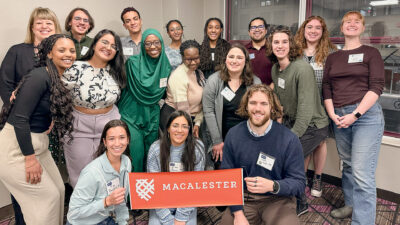
By Laura Billings Coleman / Photo by John Schoolmeesters
If you’ve been watching too much HGTV or wondering about building a guest room above your garage, you’re not alone. Since the start of the pandemic, home spending has spiked, as Americans stuck at home have started digging into repairs, diving into renovations, and pondering more efficient ways to fit family, work, and leisure into 2,000 square feet.
“The novelty of working all day at the dining-room table has definitely worn off, and we’re all looking for ways to make our houses handle all of the roles they have to fill now,” says Zoe Kardasis Sturtz ’96, co-founder of Edit Design Build Studio, a home-renovation firm based in Minneapolis’s Prospect Park neighborhood. “People have such a strong connection to their neighborhoods in the Twin Cities that helping families stay where they want to be, in spaces that work better for them, is something I really love.”
A Massachusetts native, Kardasis Sturtz first came to the Twin Cities on a prospective student visit to Macalester in the fall of 1991. “It was the day of that famous Halloween snowstorm, and the campus closed, but I just fell in love with the people, and I knew this was the place,” she says, noting that Mac’s unique urban setting was a big part of the draw. “I remember doing a project in one of [geography professor emeritus] David Lanegran’s classes where we spent time studying the neighborhoods around Macalester, and that felt so personal to me. I’ve always been interested in city living and urban design, but another layer of my interest had to do with the people in those buildings and how they live.”
After graduating from Macalester with a degree in urban studies, Kardasis Sturtz worked in a variety of fields, from event planning to personal finance. But watching the crew she hired to help renovate her first home inspired her to go back to school at Century College for a certificate in kitchen and bath design. “I found I just loved the whole process,” she remembers. “You’re buying space you can’t see until it’s done, which is such an interesting challenge.”
She learned the ropes as a designer for a small but fast-growing firm, but when the Great Recession hit in 2008, she was laid off just as her husband, architect Ryan Sturtz, lost his job in the construction bust. “That was really terrifying, both of us unemployed, in the same industry. But we just made lemonade out of lemons and launched our own business in 2009,” she says. “I don’t know how we were so brave—sometimes you don’t have a choice.”
Since then, Edit Design Build Studio has carved out a niche remaking and remodeling homes in the Twin Cities’ historic neighborhoods, making nineteenth- and twentieth-century homes work better for twenty-first-century families. While she and her husband have earned many awards in the remodeling industry, Kardasis Sturtz says she’s even more focused on earning the trust of their clients. “Remodeling is a huge financial decision, and we have to earn the trust of our homeowners in a short period of time,” she says. “When we’re tearing off the back of your house to put up a $400,000 addition, you have to believe me when I tell you I’ve got your back.”
Although the mess and stress of a home renovation can be hard on homeowners (“Sometimes I feel like a marriage counselor,” she admits), Kardasis Sturtz and her husband have managed to work side by side through nearly one-hundred remodeling jobs. “My advice is, if you’re starting a project, you have to be good communicators and forgive each other when problems arise, because they always arise.” Having watched many homeowners go through the complex emotional ups and downs as the remodel moves from tear-down to completion, she adds, “Drywall is when the emotional barometer really drops—once you get through it, everything will feel better.’’
Zoe’s Home Remodeling Advice
Use HGTV for entertainment.
The time-elapsed home renovations popular on TV and TikTok leave out the messy stuff. “In the same way those reality dating shows are nothing like dating in real life, remodeling shows have nothing to do with the reality of a major renovation,” says Kardasis Sturtz. Most projects take months or even years from concept to completion, “so don’t use HGTV as research—it’s really for entertainment.”
Rethink an addition.
Multipurpose spaces today’s families want don’t always require an addition. “People will sometimes say they want to ‘pop off’ a roof, which is actually a very big undertaking,” says Kardasis Sturtz, who recommends looking for extra space in your basement, which are common to homes in the Midwest. “That can sometimes be a terrific way to add 700 square feet of living space that can make a huge difference for a family.”
Don’t Google it.
Google isn’t a great predictor of project costs. “If the information is too easy to get, it’s probably not that reliable,” says Kardasis Sturtz. If you need ballpark figures for a project, sources like Remodeling magazine’s annual Cost vs. Value Report can show you what average kitchen, bathroom, and other projects really cost in your zip code.
Beware of trendy finishes.
“I’m personally not a fan of sliding barn doors, and shiplap wall paneling that was all the rage just a couple years ago is already passé,” Kardasis Sturtz says. She recommends finding inspiration in existing materials, from using the same wood species and hardware finishes to matching historic millwork. “Even if you’re aiming for something modern, finding a way to at least nod to the historic features in your home can help take your house through another couple of generations.”
St. Paul writer Laura Billings Coleman is a frequent contributor to Macalester Today.
April 28 2023
Back to top





